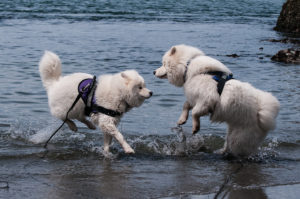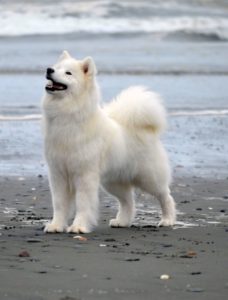Whatever It Takes
By Ron Havener
At a recent show, a reader came up to a bookstand and she was very upset. Why did Mr. Hevener kill off Kane in The Blue Ribbon? she wanted to know. How could he do such a thing!
The poor bookseller didn’t know what to say. But, had I been there, I would have done my best to reassure the reader that I never meant to hurt her in any way by having Kane meet his end in the story. I would have reminded her that, in the novel, he dies a heroic death defending his property against intruders. And I would remind her that there was a litter of puppies born for Esmeralda to play with in many stories to come. But she brought up a good point: When is it time to say good–bye? And how far should we go to hold on to the dogs we love? Let me tell you a story about “Dodge.”
Lady’s Ft. Dodge, a Black racing Greyhound, was whelped in Kansas about eight years ago. Her dam was a great producer of champion racers imported from Ireland and her sire was a large dog named New Zealand’s Greyhound of the Year. He was imported to the U.S. with great hopes and Dodge was one of his few puppies.
On a business trip to Kansas, I visited a kennel and saw some of the most stunning Greyhound pups I had ever seen. I have owned or worked with many dogs in my life, of many different breeds. But these pups really caught my attention. So much so, that I came home with three of them and considered myself very lucky. It didn’t stop there. In order to secure the body type for my bloodline, I ended up getting their dam and her only sister as well.
Time went on and the pups did, indeed, turn into what I hoped. The artist in me caught his breath when they ran across the fields here, and I admired them deeply. For three years, I waited patiently for the chance to mate Dodge to the right dog. Her sister had a litter, but they didn’t compare to what Dodge had thrown. When the chance came to breed her, I selected a white & blue brindle son of Pacific Mile, the $100,000 Greyhound from Ireland. We had imported this son, raised him, and he was currently in Florida at the Palm Beach Kennel Club.He was extremely fast, but we were having some training issues at the time and he was only starting his career on the track. I had named him Hevener Marathon because his dam held a record for distance and he had traveled a long journey from Dublin to Kennedy Airport in New York as a puppy. It had also been very difficult acquiring him because the Breeder didn’t want to sell.
When a valuable male dog is away traveling and won’t be available for breeding if we need him, we occasionally store frozen semen at the nearest facility for that purpose. This assures us that we will be able to produce a litter when needed and such was the case with Dodge. Telling myself that this might be her last litter, I arranged for her to be surgically bred at the genetics department of the University of Pennsylvania, in Philadelphia. Because it was a slow build until she reached the right day, Dodge was there for about a week and the surgery was a success. But, over the next 48 hours, that success turned into a lonely nightmare. I say lonely, because none of us understood what happened.
Many animal lovers have lost their pets in heart–wrenching ways. When it’s happening right in front of your eyes, there isn’t anything you wouldn’t do, anything you wouldn’t pay. Save my pet! Save this pet I love!
But at what price? Is it wise for us to say, yes – save my pet at any cost? Or is that a callous question? Is it fair for veterinarians to charge us many thousands of dollars to save dying pets? Or is that also a callous question?
Where the pet and owner separate is a matter of speculation. We do know that what affects one, affects the other. Treating the pet is also treating the owner, and, therefore, the veterinarian becomes a healer on many levels. But, the veterinarian is in business. The service is not free “because you are kind and loving to an animal that needs saving.” Or, because anyone else sees your pet in the same, special way that you do. If you cannot pay the bill, all sympathy will be forgotten and the bill collector will be as nasty to you as to anyone else.
As I write this, Dodge is probably going to make it thanks to the care that about $5,000 can buy. Can her pregnancy be saved? Nobody knows right now. I do know that sympathy for a dog in need wasn’t why Dodge received the extra surgery, medications, and everything else it took to pull her through. She only got those things because someone would pay for it.
As I sat with other pet owners in the emergency waiting room, I sensed fear, grief and tremendous outpouring of love in cases that, I knew, would not end in joy. How can you save the mixed Spaniel flopping limp in his weeping master’s arms? How can you save the Rottweiler that collapsed at home, traveled four hours and arrived barely breathing? I understood the passion of those who loved them. And I asked myself for the truth: Were these people in any state of mind to make sensible decisions? I couldn’t talk to anyone else at that moment. It’s not the time or place for one stranger to ask another “This could amount to a lot of money. Are you sure you understand that?”
Deep down, how do we really feel about paying whatever it takes – even when we know that sometimes we are billed for mistakes or shoddy care and no one thinks twice about charging us for it? I’d like to know what readers think about these things. I’d like to know how you feel about veterinarians charging for things that sometimes go wrong in their clinic – their own mistakes – but charging you for it with little or no show of conscience. I’d like to know what you think about paying (and being asked to pay while you are in emotional, spiritual and psychological distress) whatever it takes to save the life of your pet. I’d like to know if you ever pulled a pet through no matter what and then, later, honestly wondered if it was really the right thing to do – or, if it might have been more kind to say, “Thank you, my friend. I love you and I know we’ll meet again. But, for now, it’s time for us to say good–bye.”







